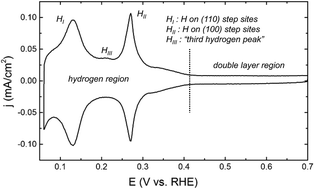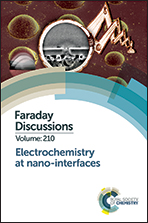Hydrogen adsorption on nano-structured platinum electrodes
Abstract
The “hydrogen region” of platinum is a powerful tool to structurally characterize nanostructured platinum electrodes. In recent years, the understanding of this hydrogen region has improved considerably: on Pt(111) sites, there is indeed only hydrogen adsorption, while on step sites, the hydrogen region involves the replacement of adsorbed hydrogen by adsorbed hydroxyl which interacts with co-adsorbed cations. However, the hydrogen region features an enigmatic and less well-understood “third hydrogen peak”, which develops on oxidatively roughened platinum electrodes as well as on platinum electrodes with a high (110) step density that have been subjected to a high concentration of hydrogen. In this paper, we present evidence that the peak involves surface-adsorbed hydrogen (instead of subsurface hydrogen) on a locally “reconstructed” (110)-type surface site. This site is unstable when the hydrogen is oxidatively removed. The cation sensitivity of the third hydrogen peak appears different from other step-related peaks, suggesting that the chemistry involved may still be subtly different from the other features in the hydrogen region.

- This article is part of the themed collection: Electrochemistry at nano-interfaces


 Please wait while we load your content...
Please wait while we load your content...